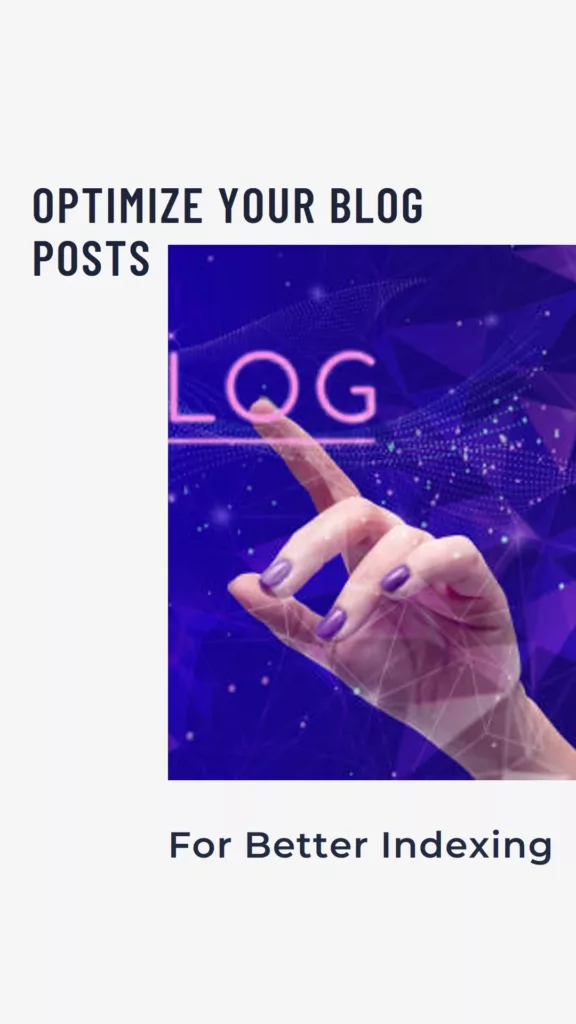Remember the first time you poured your heart into a blog post? Polished every sentence, inserted witty images, and hit publish with the giddy anticipation of internet applause. Then, crickets. You refreshed, searched, and scoured the digital wasteland, only to find… NADA. Your creation, your masterpiece, is swallowed in the Google abyss.
That crushing feeling of invisibility has plagued all of us at some point. But today, we take back the power. This isn’t just a guide to Google indexing – it’s a super highway to the top of the search results, a roadmap to conquering the SEO beast, and a shield against the dreaded post-publish void.

Forget “unlocking secrets” and “hacking algorithms.” We’re demystifying the process, brick by logical brick. You’ll understand how Google thinks, we will dance with the crawlers and craft content so magnetic it practically begs to be indexed and ranked at #1.
We’ll dissect technical tweaks, and content strategies sharper than a samurai sword, and even tackle those pesky indexing fluctuations that make your website stats resemble a drunken rollercoaster.
So, join me, if you dare, on this journey from obscurity to omnipresence. No clickbait promises, just actionable strategies and the sweet satisfaction of seeing your blog bask in the warm glow of search engine glory. After all, your words deserve to be heard, seen and celebrated. Let’s make that happen, together.
(P.S. Remember that niche article you wrote about? Turns out, great content + smart indexing = traffic goldmine. We’ll explore that connection too!)
Google Indexing 101
From Invisible Ink to Spotlight Stealer
Imagine you poured your heart into a blog post, a symphony of words and wit, only to discover it’s vanished into the digital ether. Google search results? More like a tumbleweed rolling across a deserted online landscape. No need to cry into your keyboard just yet, dear blogger, because today we’re cracking open the Google indexing vault and unveiling its secrets in plain English.

Think of the internet as a bustling library, and Google as the meticulous librarian diligently organizing the shelves. Crawlers, these digital bookworms, scour the web, sniffing out websites and pages like a truffle pig on a mission. Once found, pages get indexed and shelved neatly in the vast Google library based on their content and relevance. But don’t worry, there’s no Dewey Decimal System here – Google’s algorithms employ complex magic to ensure your masterpiece ends up in the right (and most-searched) sections.
Step 1: Crawling By The Curious Googlebot
Picture Googlebot, not as a faceless AI overlord, but as an enthusiastic bibliophile with insatiable curiosity. It follows links, and hops from website to website, sniffing out fresh content like a bloodhound on a scent trail. Your blog, hopefully, catches its eye through strategic links from other established websites (think friendly book recommendations) or even mentions on social media (whispers across the library gossip mill).
Step 2: Indexing: From Crawling to Categorizing

Once Googlebot discovers your post, it’s time for analysis. Imagine the librarian meticulously examining each page, identifying keywords, understanding context, and ultimately deciding where it belongs on the vast Google bookshelf. This is where your title tags, meta descriptions, and on-page SEO come into play – think clear labels and detailed summaries that accurately describe your literary masterpiece.
Step 3: Rankings Are The Final Showdown for Search Engine Supremacy
Now, for the pièce de résistance: the battle for rankings. Think of it as the library’s popularity contest, where pages compete for prime real estate on the first few shelves (search results pages). Google’s algorithms, a complex orchestra of factors, judge each page based on its relevance, content quality, user engagement, and even mobile-friendliness (is your library accessible to everyone?).

Remember, even with stellar content, indexing isn’t always instant.
Think of it as the librarian prioritizing new acquisitions while tending to existing shelves. Patience and consistency are key. By regularly publishing high-quality content and optimizing your SEO, you’ll increase your chances of catching Googlebot’s eye and securing a coveted spot on the digital bookshelf.
This is the process, so let’s take a deeper look into each step, exploring technical tweaks and content strategies to ensure your blog posts waltz gracefully through the indexing process and conquer the ranking competition. Stay tuned, folks, because the next chapters hold the secrets to turning your blog from invisible ink to a search engine spotlight stealer!
Optimizing Your Blog Posts for Indexing

Remember the dusty attic your parents swore didn’t exist? That’s how Google sees an unoptimized blog post – hidden away, gathering digital cobwebs. Don’t worry, though, because today we’re transforming your blog from a dusty attic into a search engine wonderland, attracting Googlebots like a magnet draws stray kittens.
Think of optimization as turning on the lights and sweeping out the cobwebs in your attic. By making your blog post easy for Googlebot to find and understand, you dramatically increase its chances of landing on that coveted first page of search results. Let’s delve into the technical tactics and content strategies that will guide Googlebot straight to your masterpiece:
How is Your Post Built
1. On-Page SEO Are Sparkling Signposts
Imagine your blog post as a magnificent castle, but dark and without lights, no signs of life anywhere. The Googlebot might just wander right past. That’s where on-page SEO comes in.
Craft your title tags like dazzling neon signs, announcing your content in clear, keyword-rich terms. Meta Data descriptions are your enticing welcome banners, summarizing your post and beckoning readers (and the Googlebot) inside.

Header tags act as internal roadmaps, guiding readers and bots through your content’s various chambers. Remember, keyword stuffing is a faux pas – think quality over quantity, ensuring your keywords reflect the essence of your post naturally.
2. Website Structure/Internal Links Light the Corridors
A confusing maze of interconnected rooms might leave even the most adventurous explorer (or Googlebot) lost. Structure your website with clear navigation menus, logical internal linking between related posts, and a sitemap. The sitemap is the blueprint of your entire blog domain. Think of it as a friendly map welcoming the Googlebots with a “Come in, We’re open!”
3. Mobile-Friendliness Opens the Drawbridge
In today’s digital age, ignoring mobile users is like locking your castle gate to half the visitors. Ensure your blog is mobile-responsive, adapting seamlessly to smartphones and tablets. Think of it as building a drawbridge that accommodates all kinds of travelers, welcoming the Googlebot (and its mobile-loving companions) with open arms.
Content Strategies to Fill the Castle with Treasures
1. High-quality, Informative Content is The Sparkling Jewels
Think of your content as the sparkling jewels within your blog castle. Googlebot craves high-quality, informative pieces that answer users’ queries and add value. Research your topic, provide unique insights, and inject your personality to keep readers engaged. Remember, quantity isn’t everything – focus on creating well-researched, in-depth articles that satisfy readers’ thirst for knowledge.

2. Regular Publishing is Like an Open Banquet Hall
Just like a neglected castle fades into disrepair, an un-updated blog loses its allure for Googlebot. Commit to a regular publishing schedule, keeping your blog in a vibrant, active space. Think of it as hosting a continuous banquet of fresh content, enticing the Googlebot to return for more.
3. Internal Links Interconnect the Towers
Create bridges between your blog posts through strategic internal linking. Imagine connecting the towers of your castle with secret passageways, guiding readers (and Googlebot) to explore related content. Link relevant articles within your post, keeping the information flow smooth and ensuring Googlebot understands the connections between your ideas.
4. External Links are Your Contents Welcoming Gates:

No castle exists in isolation, right? Build relationships with other relevant websites by including external links in your content. Think of it as opening your gates to welcome visitors from other kingdoms, broadening your reach, and potentially attracting the Googlebot’s attention through backlinks from established sources.
By implementing these technical and content strategies, you’ll transform your blog from a hidden attic into a content castle attracting the Googlebots like a moth to a flame.
Remember, optimization is a continuous process, so adjust your tactics, analyze your results, and keep polishing your digital palace. In the next sections, we’ll delve deeper into troubleshooting common indexing issues and explore advanced tactics for the ambitious blogger, ensuring your blog reigns supreme in the online landscape.
Decoding the Indexing Rollercoaster
You publish a masterpiece of a blog post, like this one, brimming with wit and wisdom, ready to take the search engine world by storm. You check Google, eyes gleaming with anticipation…only to find your post has vanished. Poof! Like a magician’s disappearing rabbit, it’s gone.

Fasten your seatbelt! You are being taken for a ride on the indexing roller coaster.
This is a bumpy ride we all endure. Do you know why? Today, we’ll give you the tools to navigate these dips and dives, ensuring your content stays afloat and reaches its audience.
1. Understanding Fluctuations and Why Your Numbers Tango with Uncertainty
First, let’s dispel the SEO myth of linear indexing. Imagine Google’s index as a bustling marketplace, not a static museum. Content gets added, removed, and shuffled constantly. Your blog entries are occasionally caught in the current.
Slow loading times might cause temporary delays, while Googlebots skip your content today for a lack of time. They may revisit your website on a schedule that doesn’t perfectly align with your publishing rhythm. Remember, these fluctuations are normal, and a temporary dip doesn’t equate to permanent obscurity.
2. Troubleshooting the Disappearing Act and Diagnosing the Indexing Hiccups
But what if a fluctuation feels less like a tango and more like a nosedive? Don’t panic! The Google Search Console is your detective kit, offering clues to why your post might be missing in action.
The Coverage report reveals any indexing issues, while the URL Inspection tool acts like a magnifying glass, pinpointing specific problems like broken links or crawl errors. Armed with this information, you can address the technical gremlins and coax your post back into the index.
3. False Positives are When the Smoke Clears and Your Post IS There
Sometimes, the alarm bells within the Search Console ring, but upon closer inspection, your post is happily basking on the Google index. False positives happen! Remember, indexing takes time, and the Search Console might not reflect the latest changes instantly. To confirm your post’s whereabouts, perform a simple Google search using the “site:” operator (for example site:settingpoints.com).
Did you find your post there? Breathe a sigh of relief – it’s not lost, just playing hide-and-seek with the algorithms.
4. Patience is Your Compass While You Trust the Process and Enjoy the Journey
Remember, SEO is a marathon, not a sprint. Obsessing over daily fluctuations can sap your creativity and energy. Focus on consistently producing high-quality content, optimizing your technical settings, and building backlinks.

Over time, these efforts will solidify your blog’s authority and ensure Google recognizes your content’s value, keeping it visible even during the occasional indexing flip.
By understanding the nature of fluctuations, utilizing diagnostic tools, and embracing patience, you can navigate the indexing roller coaster with confidence.
Remember, temporary dips are just bumps on the road to Google glory. Keep the content flowing, the SEO ducks in a row, and trust that your blog will find its rightful place in the search engine spotlight.
In the next section, I’ll provide some tips and tricks for advanced indexing tactics for the ambitious blogger, equipping you with tools to take your content to the next level.
Beyond the Basics
Advanced Indexing Tactics for the Ambitious Blogger
You have gotten this far, now imagine that you’ve conquered the SEO Fundamentals, your blog sparkles with optimized content, and the Googlebot visits like a loyal friend. But you crave more, a higher plane of search engine visibility. As an intrepid blogger, this section unlocks the secrets of advanced indexing tactics, and tools for the ambitious who dream of dominating the digital landscape.

1. Schema Markup Goes From Plain Text to Semantic Feast
Think of your blog post as a delicious dish. With plain text, the Googlebot might just recognize it as “food.” But add Schema markup, the secret spices of structured data, and it becomes a “five-star vegan lentil stew with gluten-free crusty bread.” Suddenly, Google understands the nuances of your content, attracting targeted searches and boosting your ranking potential. Recipes, events, articles – Schema has a flavor for every content type, ready to tantalize those search engine algorithms.
Here’s how it works:
- Structured Data – Instead of just plain text, Schema adds a layer of structured data to your blog posts. This structured data is like a recipe, providing Google with a detailed breakdown of the ingredients and instructions that make up your content.
- Clearer Understanding – Google can now understand not just the general topic of your post, but also the specific entities, relationships, and attributes within it. This is like giving Google a map to navigate your content, helping it grasp the context and meaning more accurately.
- Enhanced Search Results – As a result, Google can display your content in richer and more informative ways in search results.
This might include:
- Recipe cards with images, ingredients, and cooking times
- Event listings with dates, locations, and ticket information
- Article snippets with author bios, publication dates, and key takeaways
- Product listings with prices, reviews, and availability
Benefits of Using Schema Markup
- Improved Visibility: Your content becomes more visible and relevant in search results, attracting more clicks and visitors.
- Boosted Ranking Potential: Google may give higher ranking preference to pages that use Schema, as it signals a well-structured and informative website.
- Enhanced User Experience: Rich snippets provide a more engaging and informative experience for users, making them more likely to click on your results.
In essence, Schema markup is like adding a sprinkle of magic to your content, helping it stand out in the crowded search engine landscape. It’s a powerful tool that can elevate your blog’s visibility, ranking, and user experience, making it an essential ingredient for any ambitious blogger’s SEO strategy.
2. AMP is the Speed Demon for the Mobile Age
In the digital world, slowness is kryptonite. Enter AMP, Accelerated Mobile Pages, your blog’s sleek sports car for the mobile highway. AMP strips away non-essentials, optimizing content for lightning-fast loading on smartphones and tablets.
Think of the Googlebot zooming past clunky websites, stopping only to admire your streamlined AMP masterpiece. Remember, mobile-friendliness is no longer a nice-to-have, it’s a necessity. AMP lets you embrace the mobile revolution and outrun the competition in the search engine race.
3. Canonicalization Conquers the Content Doppelganger
Envision having a twin who steals your clothes and confuses everyone! That’s duplicate content in the SEO world, a potential roadblock to indexing success.
Canonicalization is your secret weapon, the official “This is the real me!” tag for your content. By specifying the preferred version of your post, you guide the Googlebot through the maze of doppelgangers, ensuring your original gets the credit and visibility it deserves.
Here’s how it works:
- Identifying Duplicate Content – Canonicalization comes into play when you have multiple versions of the same content, or very similar content, accessible through different URLs. This can happen due to:
- Using different URL structures (e.g., with or without trailing slash)
- Sorting or filtering options that create unique URLs
- Syndicated content appearing on multiple websites
2. Choosing the Master Copy – You, as the website owner, select the “master copy” or “canonical version” of the content—the one you want Google to consider as the original and most authoritative.
3. Adding a Canonical Tag – You place a canonical tag, a snippet of code, in the HTML of the duplicate pages. This tag tells search engines: “Hey, this page is a copy, but the real deal is over here at this URL.”
4. Consolidating Authority – Google follows the canonical tag and consolidates all ranking signals, backlinks, and authority to the canonical URL. This prevents duplicate content from competing with itself in search results, ensuring that the original version gets the credit it deserves.
Benefits of Canonicalization
- Avoids Duplicate Content Penalties – Google penalizes websites with excessive duplicate content, as it can be seen as manipulative and spammy. Canonicalization helps you stay in Google’s good graces.
- Improves Crawl Efficiency – The Googlebot doesn’t waste time crawling and indexing multiple versions of the same content. With billions of pages to crawl, this leads to faster and more efficient indexing.
- Strengthens Your Content’s Authority – By consolidating ranking signals to the canonical URL, you make that page stronger and more likely to rank higher in search results.
In essence, canonicalization is like assigning a unique fingerprint to each piece of content, ensuring that Google recognizes the original and authoritative version, even when faced with multiple copies. It’s a crucial tool for maintaining a well-organized and efficient website, preventing duplicate content issues, and maximizing your SEO efforts.
Remember, canonicalization clarifies authority and prevents unnecessary indexing headaches, keeping your content kingdom organized and thriving.
4. Structured Data Types That Differentiate From Recipes to Rockstars
Schema and AMP might be the main courses, but structured data types are the delectable side dishes, adding flavor and specificity to your content. Whether you’re writing about music artists, movies, or local businesses, specific data types like MusicML, MovieML, or Local Business Schema tell the Googlebot exactly what’s on your plate.
Searchers are craving your unique recipe, and Google is serving it up perfectly thanks to the right data type. Remember, these details matter, attracting relevant audiences and boosting your chances of landing on coveted search result snippets.
5. A Word of Caution About Advanced Tactics for Seasoned Chefs
Advanced indexing tactics are powerful tools, but wield them wisely. Remember, focus on quality content first, mastering the SEO fundamentals before diving into Schema, AMP, and data types.
Think of them as spices – overuse can overpower the dish. Implement these tactics strategically, analyze their impact, and adjust your approach accordingly. Embrace experimentation, but never jeopardize the core value and flavor of your content.
By venturing into the realm of advanced indexing tactics, you’ll equip your blog with the tools to stand out from the crowd, attract targeted audiences, and conquer the search engine summit.
Remember, this journey is about continuous learning and refinement. Keep exploring, stay informed, and never stop experimenting. With dedication and these advanced strategies, your blog will rise to the top, shining like a beacon in the vast digital landscape.
What We Learned Today
With the Google Indexing question solved, the SEO secrets are whispered in your ear. Remember, conquering search engines isn’t a one-off feat, it’s a tango with algorithms, a chess match with bots, and a continuous quest for visibility all rolled into one.
But with the tools gleaned from this guide, you’re no longer a wide-eyed newbie lost in the digital wilderness. You’re now a savvy investigator, armed with:
- The Map – Understanding how Google crawls, indexes, and ranks your content, you’ll navigate fluctuations with grace and optimize your posts for maximum discoverability.
- The Compass – Technical tweaks and strategic content strategies to guide your blog through the SEO maze. This ensures smooth indexing and attracts the Googlebot like moths to a flame.
- The Magnifying Glass – Troubleshooting tools that empower you to diagnose indexing hiccups and banish false alarms, keeping your content visible and accessible.
- The Secret Spices – Advanced tactics like Schema Markup and AMP add an extra layer of flavor to your content, tantalizing search engines and boosting your ranking potential.
Now, it’s time to take action
If you found this content helpful, leave me a comment below.
Remember, SEO is a marathon, not a sprint. Celebrate the small victories, learn from the dips, and most importantly, never stop experimenting.
And hey, if you get stuck, remember, that the Wealthy Affiliate community is vibrant and buzzing with fellow SEO adventurers. Reach out, share your experiences, and together, we’ll turn our blogs into glittering beacons in the vast digital landscape.
Go forth, conquer the Google beast, and remember, your words deserve to be heard. Make them echo through the search engines, and let your voice reach the world.
Need a better explanation of the Google Search Console, please feel free to ask in the comments below.








